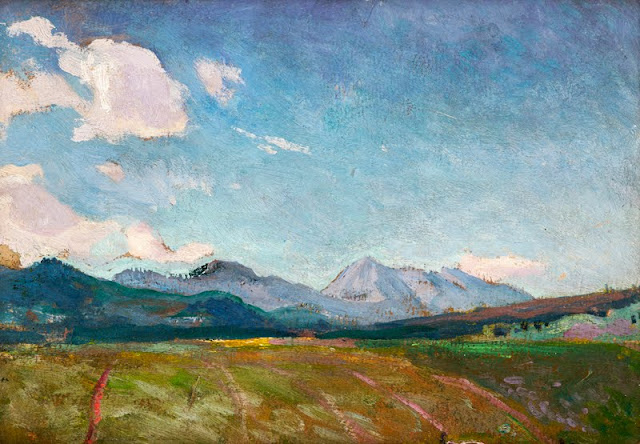GIOVANNI GIACOMETTI (1868-1933)
Monte Generoso or Calvagione (1,701m - 5,581ft)
Italy - Switzerland border
In Vue de Capolago vers 1907, oil on canvas, Musée d'Orsay, Paris, France
The mountain
Monte Generoso (1,701m - 5,581ft) also known as Calvagione is a mountain of the Lugano Prealps, located on the border between Switzerland and Italy and between Lake Lugano and Lake Como. The western and southern flanks of the mountain lie in the Swiss canton of Ticino, whilst the north-eastern flanks are in the Italian region of Lombardy.[
The view from the summit of the mountain - one of the most outstanding panorama summits in Alps- encompasses the lakes of Lugano, Como, Varese and Maggiore. To the north are the Alps, stretching from the Matterhorn via the Jungfrau and the Saint-Gotthard Massif to the Bernina Range. To the south are the Lombardy Plains and the Po Valley, with the city of Milan and the Apennine Mountains visible on a clear day.The summit can be approached by the Monte Generoso Railway, a rack railway that starts from Capolago in Switzerland, and climbs via the western flank of the mountain. The summit station includes a panoramic terrace and buffet, a restaurant and a hotel. A paved path links the railway's summit station to the summit proper, a distance of approximately 350 metres (1,150 ft) and a difference in altitude of about 100 metres (330 ft).
There is road access from Mendrisio in Switzerland to Bellavista, some 3 kilometres (1.9 mi) from the summit and an intermediate station on the railway. Hiking trails reach the summit from different starting points, including Bellavista, Capolago and Mendrisio.
The Monte Generoso Observatory is located adjacent to the railway's summit station, and is operated by the Monte Generoso Insubrica Astronomy Group.
The summit can be reached in any time of the season. In winter the ascent is quite long, everything depends of the snow conditions on the road. The train starts to operate when the snow is cleared. It is highly recommended to climb Monte Generoso when the visibility is best. You can hike or climb up there for fun any time.
The mountain slopes are home to a herd of between 300 and 350 chamois.
The artist and author Edward Lear spent summers from 1878 to 1883 on the mountain. His oil The Plains of Lombardy from Monte Generoso (Ashmolean Museum, Oxford) painted at the summit gives a good idea of the view but doesn't show the mountain itself.
The artist
Giovanni Giacometti was a Swiss painter, the father of the famous painter and sculptor Alberto Giacometti, and of Diego Giacometti, the furniture designer as well as the father of the architect Bruno Giacometti ! In 1886, he studied painting at the School of Decorative Arts in Munich, where he met Cuno Amiet the following year. Both decide to pursue their studies in Paris, in October stood at the Académie Julian, where Giacometti remains until 1891.
In 1893, shortly after his return to Switzerland, to Bergell, he became friends with Giovanni Segantini, his eldest ten years, which has great influence on his work by opening it to the beauty of the mountain scenery and the rules of divisionism. After his sudden death in 1899, Giacometti met Ferdinand Hodler, who teaches him to create a rigorous and ornamental composition by appropriate use of shapes and colors...
______________________________
2017 - Wandering Vertexes...
by Francis Rousseau


























